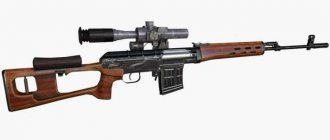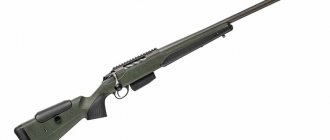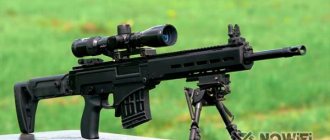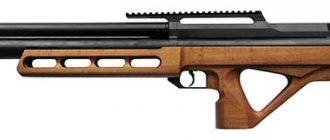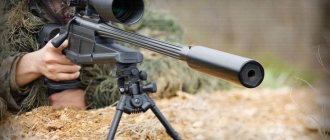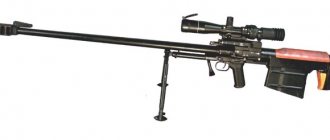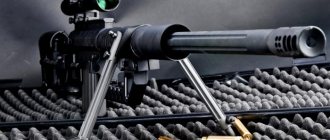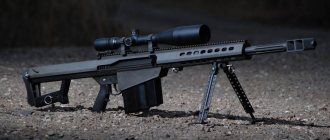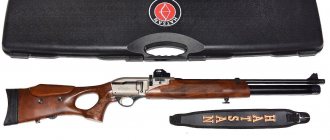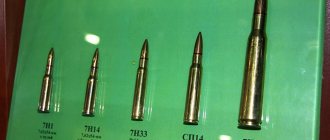Bringing the rifle to normal combat
115. All rifles in the unit must be brought to normal combat.
Checking rifles and bringing them to normal combat are carried out: a) when the rifles enter service with the unit;
b) after replacement of parts or corrections to the rifle that could change its combat;
c) when abnormal deviations of bullets are detected during shooting.
In a combat situation, each commander is obliged to use every opportunity to periodically check the combat of his rifles.
116. Checking the combat of a rifle is carried out by the commander of a platoon or company (squadron). Senior commanders, up to and including the unit commander, are required to monitor the accuracy of compliance with inspection rules.
117. When checking a battle, shooting is carried out by spotters selected by order of the company (squadron) commander from among the best shooters.
118. Before checking the combat, rifles must be carefully examined and, if necessary, corrected. A weapons technician or gunsmith with the necessary tools must be present during the inspection.
119. The combat check is carried out in the presence of the shooters, to whom rifles are assigned, and their squad commanders.
120. Checking the firing of a rifle should be carried out in favorable conditions for shooting (in warm and clear weather, in calm conditions); as a last resort, in a closed shooting range or on a shooting range protected from the wind.
121. Checking the combat of a rifle is carried out by shooting at 100 m with a sight of 3. Shooting is carried out with cartridges with a mod. 1908, one factory and one batch. The target is a white shield measuring at least 1 m in height and 0.5 m in width with a black rectangle mounted on it measuring 30 cm in height and 20 cm in width. Sighting is carried out without a bayonet.
122. The aiming point is the middle of the lower edge of the black rectangle. It should be approximately at the height of the shooter's head.
123. Along a plumb line above the aiming point, the normal position of the midpoint of impact is marked (with chalk or colored pencil). When shooting with scope 3, this point should be 17 cm higher than the aiming point. The marked point is a control point when determining the accuracy of the rifle.
124. Shooting is done lying down from a rest position. A bag loosely filled with sawdust is used as a stop. When shooting from a rest, the shooter's left hand, supporting the rifle, should rest on the rest.
125. To check the combat of the rifle, the sighter fires four shots in a row, carefully and uniformly aiming at the lower edge of the black rectangle, without changing the position of the body and left hand during the shooting process.
126. At the end of the shooting, the commander inspects the shield and, based on the location of the holes, determines the accuracy of the rifle’s combat and the position of the midpoint of impact.
127. A rifle strike is considered normal if all four holes or three of them (if the fourth sharply deviates from the rest) fit into a circle (dimension) with a diameter of 15 cm and if the average point of impact is no more than 5 cm away from the control point in any direction.
128. If the holes do not fit into a circle with a diameter of 15 cm or the average point of impact deviates from the control point by more than 5 cm, the commander, with the participation of a weapons technician or master, determines the reasons for the scattering of bullets and their sharp deviation from the control point. After establishing the reasons for the scatter, the rifle is corrected by a gunsmith, if possible, right there on the battlefield inspection site. After correcting the rifle, shooting is repeated. If the shooting result is unsatisfactory again, the rifle is sent to a weapons workshop; A report card is sent along with the rifle, noting the hits of the first and second shooting.
129. If the accuracy of the rifle meets the requirements, and the deviation of the midpoint of impact from the control point is greater than normal, but not more than 15 cm, then the rifle is handed over to the gunsmith for appropriate movement of the body or the front sight rod, depending on the nature of the deviation of the midpoint of impact.
By appropriately shifting the body or rod of the front sight, the deviation of the average point of impact is brought to a limit not exceeding 5 cm.
130. The rifle combat test is considered complete when the rifle ensures accurate shooting, i.e., at least three out of four holes fit into a circle (dimension) with a diameter of 15 cm and the deviation of the average point of impact from the control point does not exceed 5 cm.
131. The results of the combat check are recorded in the report card of the given rifle and in the fighter’s individual shooting book. Holes are marked with dots, and the position of the midpoint of impact is marked with a cross.
Rifle SVT-40
Tokarev self-loading rifle
SVT-40 stands for Tokarev Self-Loading Rifle Model 1938 and 1940. Among the soldiers it was called “Sveta”, “Svetka”. In addition to the SVT-38 and SVT-40, these rifles include the Tokarev Automatic Rifle AVT-40.
The rifle was supplied to the army as “7.62-mm self-loading rifles of the Tokarev system of the 1938 and 1940 models SVT-38, SVT-40” under the designation GAU 56-V-223S (SVT-38). About 20,000-40,000 Tokarev automatic carbines were produced on the SVT basis.
Information about the Tokarev carbine is very scarce; it is known that the carbine had an aiming range of up to 1000 meters, the ability to conduct automatic fire, and that it was created in 1938. The carbine size was 1045 mm.
The Tokarev rifle was supposed to become the main rifle of the Red Army and replace the outdated “three-line”. History of creation There are many conflicting reviews about the SVT-40 from WWII weapon owners and firearms enthusiasts. Some say it is perfect if you take care of it, others say it is capricious and imprecise. At the same time, few people gave detailed answers about the rifle. A bad rifle - no point in discussing it, period. With all this, the rifle went through the war and was produced in sufficient quantities. Although the rifle had its shortcomings, they often forget to say that in the whole world only the USA and the USSR had self-loading rifles at the beginning of the Second World War. Plus, the rifle was produced during the difficult war years, when price and quantity were more important instead of quality and reliability. The problem that the rifle is bad is the statement of those people who did not have to shoot from it and run through the trenches with it. But at the same time, captured SVT-40 rifles were very popular among the Germans and Finns. Despite the fact that they could afford to purchase or produce high-quality small arms, despite the fact that they did not feel any love for the weapons of the Soviet Army. Let's try to figure out what the Tokarev rifle was. Despite the fact that the rifle was afraid of dirt, bulky, and unreliable... For the first time, Fyodor Vasilyevich Tokarev (1871-1968) presented the first prototype of a self-loading rifle back in 1908, when he was training at the Officer School near St. Petersburg. The automatic rifle was powered by the energy of the short stroke of the barrel. The cartridge was locked using a rotating cylinder. So the prototype and the SVT are not technically similar.
Before the start of the First World War, Russia wanted to create a kind of firearms design bureau near St. Petersburg in the city of Sestroretsk. This design bureau should have included V.A. Degtyarev, who helped V.G. Fedorov and Tokarev. In 1914, a prototype of Tokarev was presented to the military commission, but WWII delayed testing, followed by a revolution. After which Tokarev was transferred to the Izhevsk Arms Factory in 1919, and in 1921 to the Tula Arms Factory as a gunsmith designer. Working in a design bureau under Soviet rule, he creates a modernized version of the Maxim machine gun on a bipod with a rifle stock and air cooling. In 1926, Tokarev showed the military a rifle chambered for 7.62x54 mm with a permanent magazine for 10 rounds and automatic recoil of the barrel with a short stroke. But the rifle did not receive approval, since the military had a requirement that the rifles could use a grenade launcher adapter. Already with a new rifle in 1930, Tokarev introduced a 7.62-mm rifle with automatic operation by removing part of the powder gases, the gas fairing was located under the barrel, and the barrel was locked by turning the bolt cylinder. At the same time, development of the Degtyarev rifle and Simonov rifle was carried out. Some rifles were planned to be equipped with detachable magazines and automatic fire mode (bursts).
The Tokarev rifle did not receive much attention, since it was decided to produce the Simonov ABC-36 automatic rifle, the production of which began in 1934. Around this time, Tokarev created the legendary TT pistol (Tula Tokarev). On May 22, 1938, the People's Commissariat of Defense announced a new competition to create a self-loading rifle chambered for 7.62x54 mm. The requirement for the rifle was the survivability and reliability of the rifle during combat operations. Ability to conduct with regular and surrogate patrons. The military commission was presented with S.G. rifles. Simonova, F.V. Tokareva, N.V. Rukavishnikov, all rifles had removable magazines for 10-15 rounds and automatic operation due to the removal of part of the powder gases. In September 1938, a military commission decided that none of the submitted rifles met the requirements. Then, after finalizing the comments, on November 20, 1938, the Tokarev rifle showed the best requirements. On February 26, 1939, the Tokarev rifle was adopted by the Red Army as a “7.62-mm self-loading rifle of the Tokarev system, model 1938 (SVT-38).” SVT-40 in analysis Even after the SVT-38 was adopted by the Red Army, the question of what the soldier would be armed with was not resolved. Since the Simonov rifle was easier to produce. For example, the SVT-38 rifle consisted of 143 parts, the Simonov rifle from 117, the SVT-38 had 22 springs, and the Simonov rifle 16, and the production of the SVT-38 required 12 different grades of steel and 7 in the Simonov rifle. But on July 17, 1939, the committee of the Council of People's Commissars of the USSR decided to end discussions on the choice of rifle, since the Red Army really needed a semi-automatic rifle and the country had to start production. On July 2, 1939, the People's Commissariat of Defense signed a production order for the production of SVT-38: in 1939 - 50,000, in 1940 - 0.6 million, in 1941 - 1.8 million, in 1942 - 2 million. The first plant The Tula Arms Plant became the center for the production of SVT-38, which housed a technical bureau that prepared technical documentation for the creation of SVT-38 at other factories. About 100,000-150,000 SVT-38 rifles were manufactured.
The rifle received its first baptism of fire during the Soviet-Finnish War “Winter War” in 1939-1940. Then the military demanded that a number of improvements be made to the design of the rifle: reduce the weight and strengthen the stock. There were complaints from countries about the weight of the rifle, despite the fact that the Tokarev rifle weighed 0.7 kg less compared to the Mosin-4 kg rifle versus 4.5 kg. Due to inexperience, fighters often lost the detachable magazine and complained about its loss. For this reason, they wanted to equip the rifle with a non-removable magazine. During the Winter War, most of the SVT-38 rifles were lost or captured by the Finns. After modifications, on April 13, 1940, the modernized rifle “7.62-mm self-loading rifle of the Tokarev system mod. 1940 (SVT-40)." Production of the SVT-40 began on July 1, 1940.
The SVT-40 was used as a sniper rifle. So a boring was made on the bolt frame to accommodate a bracket for a PU sight. Real sniper shooting with a sniper scope could not exceed 1000 meters, since a 3.5x scope with a “stump” did not allow it, since the scope was designed for firing at 1300 meters, we remove ideal conditions from here, add reality and get 1000 meters. And during the war, snipers often preferred the Mosin Sniper Rifle, which was specifically designed for its tasks. At the same time, there were snipers who preferred the sniper version of the SVT-40 because after missing the target, they could fire a “chase” shot at the target with amendments. Thus, the sniper version of the SVT-40 rifle accounted for 3.5% of all SVT rifles produced. The production of the SVT-40 sniper rifle was stopped in October 1942, hence the misunderstanding that the production of all SVT-40 and AVT-40 rifles was stopped. Despite being discontinued from production, the sniper version of the Tokarve rifle continued to be used until the end of the war. The SVT-40 sniper had 1.6 times worse accuracy than the rifle of the sniper version of the Mosin rifle. The worse accuracy is due to the shorter barrel length compared to the Mosin rifle, automatic reloading, which is always inferior in terms of performance characteristics for sniper fire. Also, during shooting, automatic weapons often damage the bullet when it is fired quickly. Automatic, which also greatly affects the accuracy of fire. During the war years, about 50,000-60,000 Tokarev sniper rifles were produced.
Sniper rifle SVT-40 On May 20, 1942, the State Defense Committee of the USSR decided to produce the Tokarev Automatic Rifle AVT-40 on the basis of the Tokarev rifle. Actual production began in July 1942. The rifle was visually no different from the SVT-40, the only difference being the safety behind the trigger, which could be set to automatic fire. The rifle could fire automatically (in bursts); the firing mode was set to the safety catch behind the trigger. AVT-40 was often made in simple workshops by remaking SVT-40. The production of the AVT-40 was a temporary measure; the task of the automatic rifle was to increase the density of fire during battle. The idea of using the AVT-40 was initially a failure, since the army already had combat experience in using the AVT-36, when it turned out that firing in bursts from a rifle was of little use, since the rifle barrel after a shot had resonance and automatic vibrations, so accuracy at 200 meters from a rifle was worse than that of the PPSh and PPD submachine guns. Plus, with 10 rounds of ammunition in the magazine, you can’t shoot much in bursts. And what is the point of conducting automatic fire when you can simply quickly shoot a magazine at a target with a higher result than bursts. The new Tokarev rifle was distinguished by an elongated metal casing, as this provided better performance characteristics, since the barrel was less subject to overheating during long shooting. The ramrod from the outside was installed in the classical way under the barrel, inside the stock. With the lengthening of the metal casing, the number of stock rings decreased from two to one. Also, the length of the rifle was comparable to the Mosin rifle. The detachable bayonet of the knife was replaced, which was reduced from 480 mm (360 mm blade) to 372 mm (243 mm blade). The bayonet was worn during battle, in free time it was worn in a scabbard on a belt, the rifle was zeroed without a bayonet, the bayonet knife had a sharpening on one side.
The weight of the rifle was reduced by 0.3 kg and amounted to 3.8 kg. For the creation of the SVT semi-automatic rifle in 1940, Tokarev was awarded the Stalin Prize, the title of Hero of Socialist Labor, and the degree of Doctor of Technical Sciences. The main arms factory for SVT-40 was the Tula Arms Factory.
In July 1940, 3,416 rifles were produced, in August - 8,100, in September - 10,700.
The production capacity of the Izhevsk Mechanical Plant, which produced the ABC-36, was adapted for the production of the Tokarev rifle.
Determining the midpoint of impact
132. To determine the average point of impact with a small number of holes, a graphical method is used, the essence of which boils down to the following:
a) to determine the average point of impact on two holes, the latter are connected by a straight line, and the distance between them is divided in half; the division point is the midpoint of the impact;
b) with three holes, the average point of impact for any two holes is first determined; then the found point is connected by a straight line to the third hole, and the distance between them is divided into three equal parts; the division point closest to the first two holes will be the midpoint of impact;
c) the average point of impact for four holes is determined in the same way, i.e., first the average point of impact for any three holes is found, the found point is connected to the fourth hole by a straight line, and the distance between them is divided into four equal parts; the point located three spaces from the fourth hole will be the midpoint of the hit.
133. A clearly detached hole is considered to be a hole that has deviated from the midpoint of impact of the other three holes by a distance exceeding the dispersion diameter of the three best holes.
